

209 views||Release time: Oct 17, 2025
The Scopus database is far more than a digital library; it's a powerful analytical tool that can provide a bird's-eye view of your entire research field. For savvy researchers, it's an indispensable resource for answering critical strategic questions: What are the "hot topics" right now? Which institutions are leading the way? And most importantly, who are the key people I should be connecting with?
This guide provides a step-by-step walkthrough on how to leverage Scopus's powerful features to analyze research trends and identify potential collaborators, turning a simple literature search into a strategic intelligence mission.

Understanding the trajectory of your field is essential for positioning your research to be novel and impactful. Scopus's analytics make this process straightforward.
Step 1: Start with a Broad, Well-Defined Search Begin by performing a document search that defines your research area. Don't be too narrow. The goal is to capture the entire field of interest.
Use Keywords: Use a combination of relevant keywords connected by Boolean operators (e.g., ("carbon capture" OR "CO2 sequestration") AND ("metal-organic framework" OR "MOF")).
Use Field Codes: For a more focused search, use the TITLE-ABS-KEY() field code to search within the title, abstract, and keywords of papers.
Step 2: Use the "Analyze search results" Feature Once you have your list of results, instead of reading through them, look for the "Analyze search results" button at the top of the page. This is the most powerful feature for trend analysis. It will generate a dashboard with several interactive charts:
Documents by year: This line graph is your most important tool. Does it show a steep upward curve? This indicates a "hot," rapidly growing field. Is it flat or declining? The field may be maturing or losing momentum.
Documents by source: This bar chart shows the top journals and conferences where research on your topic is published. This is invaluable information for deciding where to submit your own work.
Documents by author: This identifies the most prolific authors in the field. Who is publishing the most?
Documents by affiliation: This shows which universities, research institutes, or companies are the leading centers for this research area.
Documents by country: This provides a geographical overview of where the research is concentrated.
Step 3: Interpret the Data to Inform Your Strategy Use these insights to guide your research. If you see a new keyword suddenly appearing in recent years, it could signal an emerging sub-field worth exploring. If you notice that a particular journal consistently publishes the top papers, make it a target for your next submission.
The data you've just analyzed is also your map to finding the perfect research partners.
Step 1: Identify Key Authors and Institutions From the "Analyze search results" dashboard, you have already identified the most published authors and the top institutions. This is your starting list of potential collaborators. These are the people and groups who are most active and invested in your field.
Step 2: Dive into Author Profiles Click on the name of a promising author from your list. Scopus will take you to their detailed author profile, which is a treasure trove of information:
Publication History: See their full list of publications and track their research trajectory.
Citation Metrics: Metrics like the h-index can give you a quick idea of their impact in the field.
Co-author Network: The profile shows their most frequent collaborators. This helps you understand their research group and network.
Topics: Scopus identifies the key topics the author has published on, allowing you to quickly verify if their expertise aligns with yours.
Step 3: Analyze the Co-author Network On an author's profile, you can explore their co-authors. This is useful for identifying entire research labs or "hubs" of collaboration. If you find that several top authors in your field all frequently collaborate with each other, you've likely identified a leading research consortium.
Step 4: Refine and Reach Out Based on this analysis, you can build a short, targeted list of researchers whose work is highly relevant to your own. When you reach out, you can do so with a highly informed and personalized email:
"Dear Dr. Smith, I have been following your group's work on [specific topic], which I discovered while analyzing Scopus trends in our field. I was particularly impressed by your 2024 paper in [Journal Name]. My research focuses on [your related topic], and I believe there may be a strong synergy for a potential collaboration..."
Conclusion
By moving beyond simple keyword searches and utilizing Scopus's powerful analytical tools, you can gain a deep, data-driven understanding of your research landscape. This strategic approach not only helps you identify the most promising research trends but also provides you with a clear, evidence-based path to finding and connecting with the most relevant collaborators in the world.